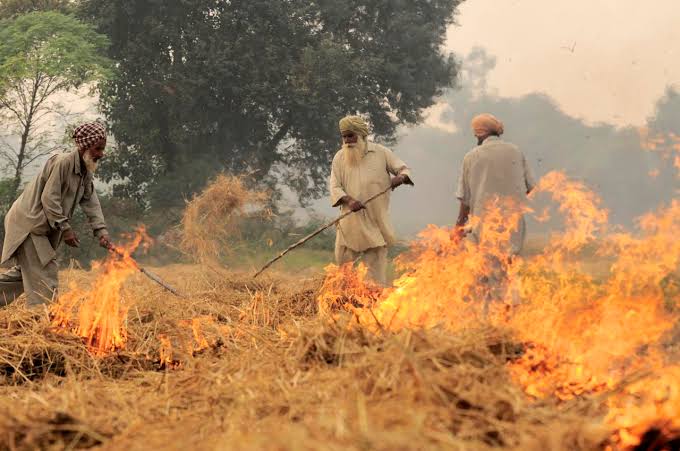With a change in temperature, the problem of Delhi’s infamous winter smog looms on the horizon with citizens and government looking for long-term solutions
The Covid-19 lockdown brought with it relief for the residents of Delhi as reduced vehicle movement and shutdown of industries brought days of clear sky and pollution free air. The Air Quality Index went down to 41 — lowest since the National Air Quality Index was launched in 2014. But now as winter is approaching, the air quality is deteriorating again. AQI on Tuesday, 6 October touched hazardous levels (over 400) in Anand Vihar area.
The major reason behind the spike in this pollution level is the seasonal stubble burning by farmers in Punjab and Haryana. Reports have started coming in from various villages that this practice has started again. Delhi too has farms in outlying areas.
Indian Agricultural Research Institute (IARI) has developed low cost ‘decomposer capsules’ to manage crop residue. It is a composition of eight microbes — four capsules costing Rs 20 can be used to make upto 25 litres solution.
CM Arvind Kejriwal on Tuesday said that the decomposer will be made available to Delhi farmers from 11 October. He also said that if this experiment is successful, spraying it on 700 hectares of land will cost just Rs 20 lakh.
IARI decomposer capsules are being used in four states — Punjab, Haryana, UP and Delhi — on a trial basis this year. To get the decomposer, farmers have to submit forms. Gopal Rai, Delhi’s environment minister, said that the government has received applications for 1,300 acres so far out of the total 2,000 acres of paddy growing area.
PUSA’s fungi-based decomposer comes as a potential solution to control crop residue burning as it is being claimed that it makes the land fertile, while burning of residue deteriorates soil quality.
Meanwhile, Class XII student Aditya Dubey and law student Aman Banka have filed a petition in the Supreme Court seeking a ban on stubble burning. However, it raises an important question: Isn’t filing a PIL a top-down approach to the problem? Field conditions and the economy of farmers have to be understood before a solution is proposed.
Small and marginal farmers can not afford the machinery for proper management of crop residue. So, banning the practice of burning of crop residue doesn’t seem to be a viable option either, unless states provide free of cost machinery.
Acting on the plea, the SC issued notices to the Centre, Punjab, Haryana and Delhi governments demanding that governments provide free of cost stubble removing machines for small and marginal farmers.
The petition cited a report by the Central Pollution Control Board saying, “The contribution of stubble burning in air pollution was around 40%”. However, data and analysis from SAFAR shows that the highest contribution to Delhi’s air from stubble burning last year was end-October till mid-November. This period also coincides with Diwali, when Delhi’s AQI becomes extremely high. The contribution of stubble burning peaked on 1 November last year.
Many reports also point towards the contribution of fossil fuel- based industries and vehicles, blaming them as a major cause of pollution. But since pollution peaks in the early months of winter due to biomass burning, it has been a major concern for the city administration as well as the Supreme Court. From time to time, the courts have given directives to the states of Punjab and Haryana to control the burning of stubble.
EPCA in its recent report submitted in SC, opposed paying the farmers as incentives for not burning residue. It suggested moving away from SC directives to Punjab, Haryana and UP in November last year of paying Rs 100 per quintal of paddy crop to farmers as an incentive for not burning the crop stubble. “This could be a perverse incentive, it may not be advisable,” EPCA said in the report.
EPCA, therefore, asked Punjab and Haryana to provide stubble management machines at operation cost and no rental.
States have not come to any solution as to who will bear this cost. Vikrant Tongad, an environmentalist who also filed a separate plea in SC regarding pollution in Gautam Buddha Nagar said in the plea, “The Central and state governments have not arrived at any conclusion with respect to the responsibility of giving this”. As per a report by the Indian Express, senior advocate Shyam Divan, who was appearing for Tongad, gave an interesting suggestion of withholding a portion of MSP till it was verified whether a farmer was indulging in stubble burning or not.
The issue of stubble burning has again come to the forefront as various international studies are being cited to say that pollution can exacerbate the pandemic — pollution coupled with Covid can become life threatening. But the issue still remains to be resolved while it has been relegated to being a political tussle.
Experts have been saying that stubble burning harms farmers as well, as the smog reaches various small cities of Haryana, Punjab and UP. Thus, the need for a sustainable and long-term solution without making farmers the culprit for Delhi’s pollution problem has never been more dire.
Hasty solutions under pressure of approaching winter always result in only the political blame game.





